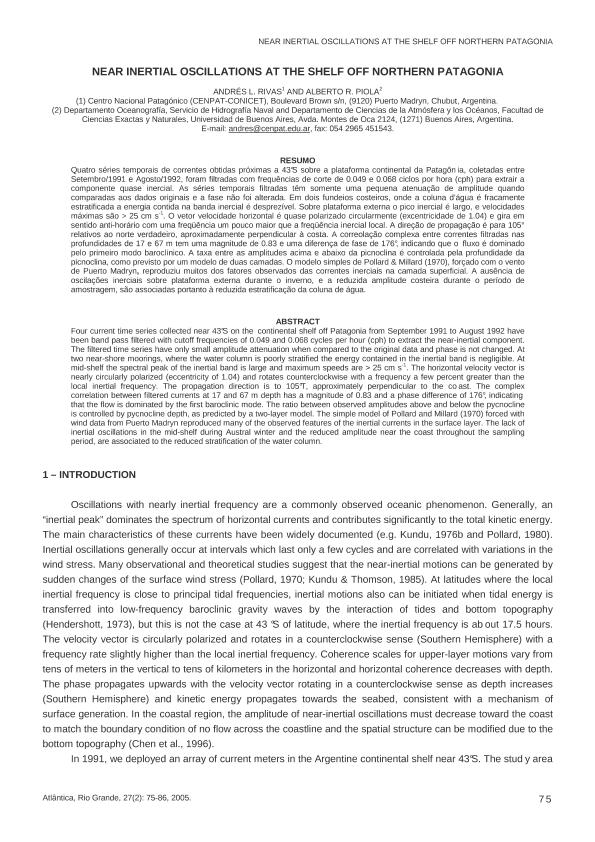Artículo
Quatro séries temporais de correntes obtidas próximas a 43°S sobre a plataforma continental da Patagôn ia, coletadas entre Setembro/1991 e Agosto/1992, foram filtradas com frequências de corte de 0.049 e 0.068 ciclos por hora (cph) para extrair a componente quase inercial. As séries temporais filtradas têm somente uma pequena atenuação de amplitude quando comparadas aos dados originais e a fase não foi alterada. Em dois fundeios costeiros, onde a coluna d’água é fracamente estratificada a energia contida na banda inercial é desprezível. Sobre plataforma externa o pico inercial é largo, e velocidades máximas são > 25 cm s-1. O vetor velocidade horizontal é quase polarizado circularmente (excentricidade de 1.04) e gira em sentido anti-horário com uma freqüência um pouco maior que a freqüência inercial local. A direção de propagação é para 105° relativos ao norte verdadeiro, aproximadamente perpendicular à costa. A correolação complexa entre correntes filtradas nas profundidades de 17 e 67 m tem uma magnitude de 0.83 e uma diferença de fase de 176°, indicando que o fluxo é dominado pelo primeiro modo baroclínico. A taxa entre as amplitudes acima e abaixo da picnoclina é controlada pela profundidade da picnoclina, como previsto por um modelo de duas camadas. O modelo simples de Pollard & Millard (1970), forçado com o vento de Puerto Madryn, reproduziu muitos dos fatores observados das correntes inerciais na camada superficial. A ausência de oscilações inerciais sobre plataforma externa durante o inverno, e a reduzida amplitude costeira durante o período de amostragem, são associadas portanto à reduzida estratificação da coluna de água. Four current time series collected near 43°S on the continental shelf off Patagonia from September 1991 to August 1992 have been band pass filtered with cutoff frequencies of 0.049 and 0.068 cycles per hour (cph) to extract the near-inertial component. The filtered time series have only small amplitude attenuation when compared to the original data and phase is not changed. At two near-shore moorings, where the water column is poorly stratified the energy contained in the inertial band is negligible. At mid-shelf the spectral peak of the inertial band is large and maximum speeds are > 25 cm s-1. The horizontal velocity vector is nearly circularly polarized (eccentricity of 1.04) and rotates counterclockwise with a frequency a few percent greater than the local inertial frequency. The propagation direction is to 105°T, approximately perpendicular to the co ast. The complex correlation between filtered currents at 17 and 67 m depth has a magnitude of 0.83 and a phase difference of 176°, indicating that the flow is dominated by the first baroclinic mode. The ratio between observed amplitudes above and below the pycnocline is controlled by pycnocline depth, as predicted by a two-layer model. The simple model of Pollard and Millard (1970) forced with wind data from Puerto Madryn reproduced many of the observed features of the inertial currents in the surface layer. The lack of inertial oscillations in the mid-shelf during Austral winter and the reduced amplitude near the coast throughout the sampling period, are associated to the reduced stratification of the water column.
Near inertial oscillations at the shelf off northern Patagonia
Fecha de publicación:
12/2005
Editorial:
Universidade Federal do Rio Grande
Revista:
Revista Atlantica
ISSN:
0102-1656
e-ISSN:
2236-7586
Idioma:
Inglés
Tipo de recurso:
Artículo publicado
Clasificación temática:
Resumen
Palabras clave:
INERTIAL OSCILLATIONS
,
SHELF
,
NORTHERN PATAGONIA
Archivos asociados
Licencia
Identificadores
Colecciones
Articulos(CCT-CENPAT)
Articulos de CTRO.CIENTIFICO TECNOL.CONICET - CENPAT
Articulos de CTRO.CIENTIFICO TECNOL.CONICET - CENPAT
Citación
Rivas, Andres Lujan; Piola, Alberto Ricardo; Near inertial oscillations at the shelf off northern Patagonia; Universidade Federal do Rio Grande; Revista Atlantica; 27; 2; 12-2005; 75-86
Compartir




